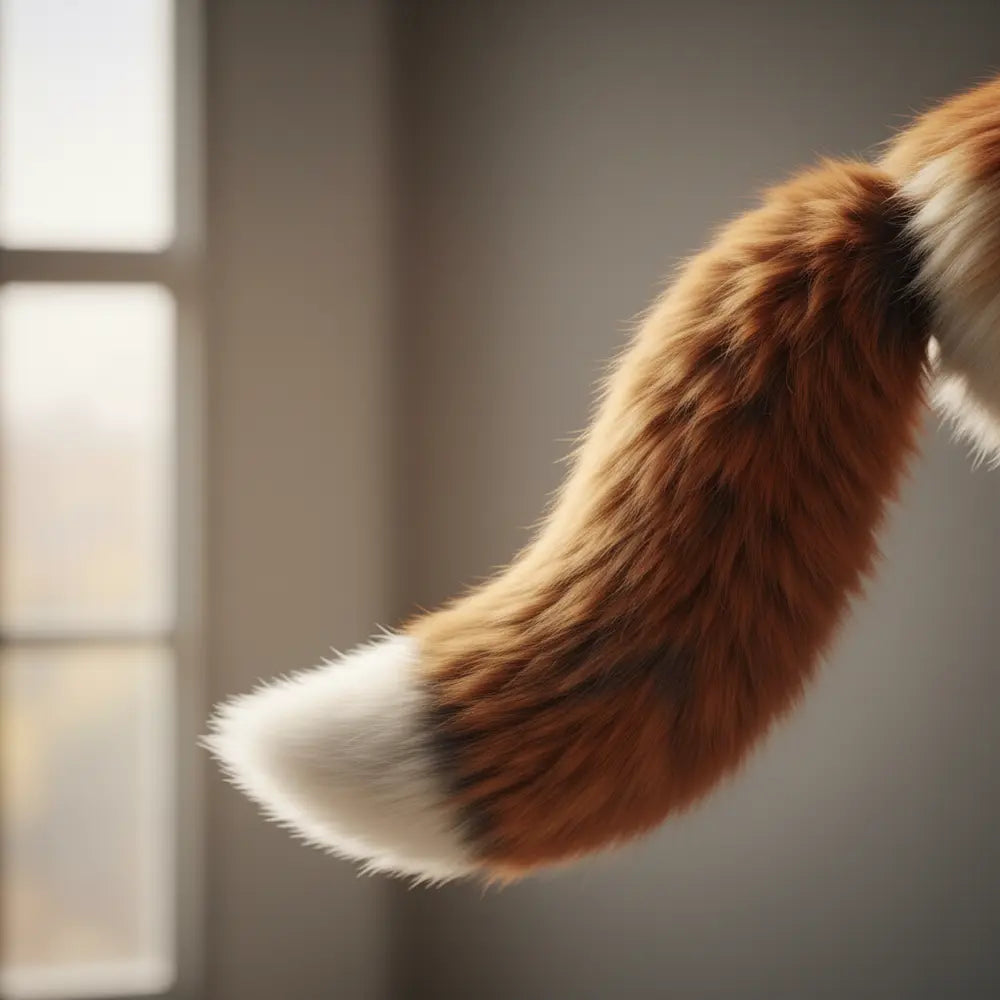
Realistic Moving Tails: Beginner’s Guide 2025
You walk onto the convention floor, a sea of incredible costumes and excited energy. Then you see it. A cosplayer with a stunningly realistic fox tail that isn't just hanging there—it’s alive. It swishes with a turn, gives a happy wag, and curls with curiosity. It’s more than a prop; it’s a performance.
This is the world of the realistic moving tail, a piece of wearable technology that elevates costumes from static displays to living art. For many newcomers, these accessories are a source of wonder and confusion. They seem complex, expensive, and out of reach for a beginner.
This guide changes that. We will explain exactly what these animatronic tail creations are, how their mechanics function, and what trends are making them so popular. By the end, you’ll know how to choose the right one for your cosplay or Halloween costume and why they are one of the most exciting cosplay tech gadgets of 2025.

What Is a Realistic Moving Tail?
Ever see a tail move on its own and wonder if it was magic? This section breaks down what these animatronic wonders are and why they're taking over.
A realistic moving tail is an animatronic costume accessory designed to mimic the natural movements of an animal's tail. Unlike a simple plush tail that just hangs limply, an animatronic version contains small motors, a skeletal structure, and a power source. This internal system allows it to wag, swish, curl, and twitch, either on command or through automated patterns.
Think of it like a small, wearable robot hidden inside a beautiful, furry shell. These accessories blend art with engineering to create a powerful illusion of life. They add a layer of expression and dynamism to a costume that was previously impossible, making the character feel more complete and believable.
These tails are not all the same; they serve different communities. A high-end cosplay tail for a specific character like Ahri from League of Legends will have multiple points of articulation and a hyper-realistic look. In contrast, a simple Halloween tail might only have a basic side-to-side wagging motion, built for fun rather than perfect accuracy.
The furry fandom also uses these tails extensively as a core part of personal expression through their "fursonas." The growing popularity of these tails in 2025 is fueled by social media. A quick search on TikTok or Instagram reveals thousands of videos showcasing this furry costume technology, inspiring a new generation of creators and fans.
Why They're Trending in 2025
The rise of the animatronic tail isn't an accident. A major factor is the increasing accessibility of technology. The components needed to build or manufacture these tails—like small servo motors and microcontrollers—are now more affordable and easier to use than ever before. This has lowered the barrier to entry for both DIY creators and commercial brands.
Another driving force is the desire for greater immersion in cosplay. Fans are no longer content with just looking like a character; they want to embody them. A moving tail adds that crucial element of behavior and personality. This trend isn't isolated to tails; similar advancements are electrifying other accessories. To see how this tech is transforming another fan-favorite item, explore our detailed guide, From Cute to Clever: What Are Moving Cat Ears?, which delves into the mechanics behind these expressive gadgets.
Industry experts estimate that interest in wearable animatronic accessories has surged by over
40%
in the last two years alone.
Finally, cultural moments have pushed them into the spotlight. Popular characters from anime, video games, and film with prominent tails have created huge demand. As cosplay continues to grow as a global hobby, so does the market for accessories that offer that "wow" factor.
How Do Animatronic Tails Work?
Feeling intimidated by the 'tech' part of these tails? We'll demystify the mechanics in simple terms, showing you the 'brain' behind the wag.
The magic of a realistic moving tail comes from a few key components working together. While the engineering can get complex, the basic principles are surprisingly straightforward. Understanding them helps you appreciate the craftsmanship and make a smarter purchase.

Mechanical Basics: Motors and Servos
At the heart of every moving tail is a system of motors. Most high-quality tails use servo motors, which are different from standard motors. A standard motor just spins continuously, but a servo can be told to move to a precise position and hold it. They are the tiny, controllable muscles of the tail.
A flexible internal skeleton, often made from plastic segments or a wire armature, runs the length of the tail. Servos are placed at key points along this skeleton. When a servo rotates, it pulls on a section of the skeleton, causing the tail to bend or curl. More servos mean more complex and fluid movements.
Power Sources: Battery-Powered Designs
All that movement requires energy. Nearly all battery powered moving tails for costumes rely on a portable battery pack, typically worn on a belt or hidden within the costume. These packs usually contain rechargeable lithium-ion batteries, similar to the ones in your phone or a power bank.
Control Methods: Remote, App, and Motion Sensors
How do you tell the tail what to do? There are three common methods for controlling a realistic moving cosplay tail with remote control.
-
Remote Control: This is the simplest method. A small, handheld remote sends wireless signals to the tail, allowing you to trigger pre-programmed movements like a "wag," "twitch," or "curl." It's direct, reliable, and great for beginners.
-
Smartphone App: More advanced tails connect to a smartphone via Bluetooth. An app offers far greater control, often allowing you to create and save custom movement sequences. You can design a slow, curious swish or a fast, excited wag, tailoring the tail's "emotions" to your character.
-
Motion Sensors: The most sophisticated tails use built-in motion sensors (accelerometers and gyroscopes) that detect your body's movements. When you turn quickly, the tail swishes naturally. When you jump, it might perk up. This creates an incredibly immersive and reactive experience, as the tail seems to move on its own as a part of you.
Types of Moving Tails for Costumes
Fox, wolf, or something else entirely—which moving tail fits your character? Let's explore the most popular styles to help you find the perfect match for your costume.
Not all moving tails are created equal. The design, realism, and mechanics vary greatly depending on the intended use. Whether you are building a specific cosplay, getting ready for Halloween, or expressing your identity in the furry community, there is a style of animatronic tail for you.

Realistic Cosplay Fox and Wolf Tails
For cosplayers, accuracy is everything. A realistic moving fox tail or realistic wolf tail with movement is designed to perfectly replicate the look, fur texture, and motion of the real animal. These are often handmade by specialized artists, featuring high-quality faux fur and complex internal armatures for lifelike articulation.
These tails are about performance. A cosplayer portraying a sly kitsune character needs a tail that can curl and gesture with intent. For these users, smoothness of motion and quiet motors are top priorities. For a gold-standard example of this artistry, the Dynamic Red Fox Moving Tail for Cosplay & Fashion serves as a benchmark, celebrated for its silent motor and incredibly fluid movements that truly bring a character to life.
The cultural significance of these accessories is undeniable. If you're intrigued by how these tails have leaped from convention halls to mainstream style, our article From Anime Con to Everyday: Why Fox Tails Are Trending explores their growing influence on fashion and Gen Z culture.
Halloween Animatronic Costume Tails
Halloween tails are built for fun and accessibility. You might find them in seasonal costume shops or large online retailers. These are typically more affordable because they use simpler mechanics. Often, they have just one motor that produces a simple, repetitive side-to-side wagging motion.
While they lack the nuance of high-end cosplay tails, they are a perfect entry point. A common misconception is that all moving tails are delicate and complicated. Halloween-grade tails are often more durable and designed for a party environment. They provide that "wow" factor without the investment or complexity of a professional-grade prop.
Furry Fandom and Pet Cosplay Accessories
For the furry community, a tail is not just an accessory; it's a part of an identity or "fursona." These tails can range from realistic to highly stylized, often featuring bright, unnatural colors or unique shapes to match a specific character design. Customization is key, and many creators on platforms like Etsy specialize in building tails to order.
This category also includes "pet cosplay," where the focus is on mimicking the behavior of a domestic cat or dog. These tails often feature more playful and emotive movements, like happy wags or curious twitches. The technology here is part of a larger trend of wearable animatronic accessories used for self-expression.
Which Animatronic Tail Fits Your Style?
1. What's your main goal for your costume?
2. How much control do you want over the tail's movement?
Buying Guide: Best Animatronic Tails in 2025
Ready to invest but scared of making the wrong choice? This buyer's guide gives you the essential checklist to find a reliable, durable, and affordable animatronic tail.
Choosing your first animatronic tail can feel overwhelming, but focusing on a few key factors will ensure you get a product that you love. The goal is to find a balance between visual appeal, comfort, and performance that fits your budget and needs.
Key Factors to Consider
Before you buy, evaluate any potential tail based on these three pillars:
-
1.
Realism and Movement Quality: Look at the fur quality. Does it look like a cheap plush toy or realistic fur? More importantly, watch videos of the tail in motion. Is the movement smooth and fluid, or is it jerky and mechanical? The best cosplay animatronic tails 2025 have seamless, quiet movements.
-
2.
Comfort and Attachment: You might be wearing this for 8+ hours. Check the weight of the tail and its power pack. A heavy tail will cause back strain. Also, examine how it attaches. Most use a sturdy belt or a harness system. A flimsy attachment will cause the tail to sag or swing unnaturally.
-
3.
Durability and Battery Life: A tail is an investment, so it should be built to last. Look for reviews that mention build quality. Are the wires protected? Is the base sturdy? Check the advertised battery life and see if it matches user experiences. A tail that dies in two hours is not practical for a full day at a convention.
Top Recommended Options for Beginners
For a beginner, the best choice is often a pre-made tail that balances quality and cost. While custom-built tails from renowned artists offer the highest quality, they can be very expensive. A great starting point is a mid-range tail from a reputable online brand or a highly-rated Etsy seller.
Look for models that offer a few pre-programmed modes via a simple remote. These provide variety without the complexity of a full app-based system. When considering a specific style, such as a realistic moving fox tail, it's helpful to see what a top-tier product offers. To benchmark what a premium product looks like, we recommend reviewing our Best Moving Fox Tails 2025: Realistic Animatronic Guide. This expert comparison will equip you to evaluate any tail on the market, ensuring you make a confident choice.
Where to Buy Your Tail
You have several options for purchasing your first wearable robotic tail for costumes:
-
Specialized Online Stores: Brands that focus exclusively on cosplay tech or animatronic accessories often have the best balance of quality and customer support. They stand by their products and offer warranties.
-
Etsy and Custom Creators: For a unique color, species, or style, Etsy is a fantastic resource. You can connect directly with an artist to create a custom piece. Always check reviews, photos, and videos from past customers to verify their quality.
-
Amazon: You can find some affordable animatronic tail options on Amazon, but be cautious. These are often the simpler, Halloween-grade models. Read reviews carefully to avoid disappointment, as quality can vary dramatically.
"I was so nervous about buying my first moving tail, but this guide's checklist was a lifesaver! I found a perfect tail on Etsy that I wore all weekend at my last con. The comfort tips were spot on."
- Alex R., Cosplayer
DIY vs. Store-Bought: Which Is Right for You?
Torn between the creative challenge of a DIY project and the convenience of a pre-made tail? We'll weigh the pros and cons to help you decide which path is best for your skills and budget.
One of the biggest questions for aspiring tail-owners is whether to build one themselves or buy one ready-made. Both paths have distinct advantages and disadvantages. The right choice depends entirely on your skills, budget, time, and desired outcome.

Pros and Cons of a DIY Animatronic Tail
Building your own tail offers ultimate creative freedom. You can choose the exact size, shape, fur, and movement patterns. For many makers, the process of building is just as rewarding as the final product. It can also be a more budget-friendly option if you already have some of the necessary tools and components.
However, the path of a DIY animatronic tail tutorial is filled with challenges. A simple project can easily take over 40 hours for a beginner. It requires a diverse skill set, including basic electronics (soldering), programming (often with Arduino), and sewing. There is also a real risk of failure—a poorly wired connection or a bug in the code can leave you with a lifeless prop.
The Best Cases for Buying Pre-Made
For most beginners, buying a pre-made tail is the recommended route. It guarantees a functional, polished product right out of the box. This allows you to focus your time and energy on other parts of your costume. For your first big convention, avoiding the stress of a last-minute technical failure is priceless.
Think of Jane, a first-time cosplayer getting ready for Comic-Con. She dreamed of a perfect realistic moving fox tail for her character. Instead of spending weeks learning to code and solder, she purchased a reliable pre-made tail. This freed her up to perfect her armor build and makeup, resulting in a cohesive and stress-free cosplay experience.
What's Your Preference?
The Future of Realistic Moving Tails
What's next for wearable robotic tails? Let's look at the exciting future, where cosplay tech gadgets become smarter, more immersive, and even more lifelike.
The world of moving cosplay tails is evolving at a rapid pace. The technology that seems cutting-edge today will be the standard tomorrow. The future promises tails that are not just accessories, but true extensions of the wearer, blurring the lines between costume and reality even further.

2025 Trends: AI-Driven Motion
The next great leap is the integration of artificial intelligence. Imagine a tail that doesn't just follow pre-set patterns but actively reacts to its environment. Using tiny cameras and microphones, an AI-powered tail could "see" a friend approaching and give a happy wag, or "hear" a sudden loud noise and twitch in surprise. This would create a level of autonomous, believable motion that is currently a dream.
Cosplay Tech Evolution
Beyond intelligence, the physical technology will continue to improve. We can expect lighter and stronger materials for the internal skeleton, making tails more comfortable to wear for extended periods. Motors will become even quieter and more efficient, and battery technology will advance to offer all-day power in smaller, lighter packs. This mirrors the evolution across all wearable animatronic accessories, as we've seen with the ever-improving designs of moving ears and wings.
Integration with VR and AR Experiences
As virtual and augmented reality become more integrated into our lives, so will our physical accessories. A programmable robotic tail could sync with a VR game, allowing you to feel your character's tail move in response to in-game actions. In an AR experience, your tail could interact with digital objects that only you can see, creating a truly mixed-reality performance.
Final Thoughts
A realistic moving tail is far more than just a costume piece. It is a fusion of art and technology, a tool for self-expression, and a gateway to a more immersive character experience. What was once a niche and complex gadget is now more accessible than ever, thanks to creative communities and advancing technology.
For a beginner, the journey into the world of animatronic tails is an exciting one. You now have the knowledge to distinguish between different types, understand their inner workings, and make an informed choice. Whether you decide to build your own or purchase a masterpiece, you are taking part in the future of cosplay.
Ready to explore more innovative cosplay accessories? Dive into our library of beginner-friendly cosplay gear guides or learn about another expressive gadget in our popular article, "What Are Moving Cat Ears?" Stay ahead of the curve and bring your next costume to life.
Frequently Asked Questions (FAQ)
1. How much does a good animatronic tail cost?
A quality, entry-level animatronic tail from a reputable seller typically costs between $150 and $350. Highly customized, multi-servo tails from specialized artists can cost $500 or more, depending on complexity and materials.
2. How long do the batteries last on a moving tail?
Battery life varies based on the tail's movement intensity and the battery's capacity. On average, a good battery pack will power a tail for 4 to 8 hours of continuous or frequent movement. Most users bring a spare or a portable charger for all-day events.
3. Are realistic moving tails heavy to wear?
They can be, which is why comfort is a key factor. A well-designed tail distributes its weight across a sturdy belt or harness. A typical tail weighs between 2 to 5 pounds (1-2.3 kg). Always check the product's weight before buying to ensure it's manageable for you.
4. Can I program my own movements into a store-bought tail?
It depends on the model. Simpler tails with remote controls have fixed, pre-programmed movements. More advanced, app-controlled tails often allow you to create, customize, and save your own unique motion sequences, giving you full creative control over the tail's "personality."




